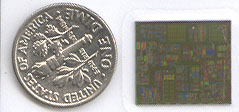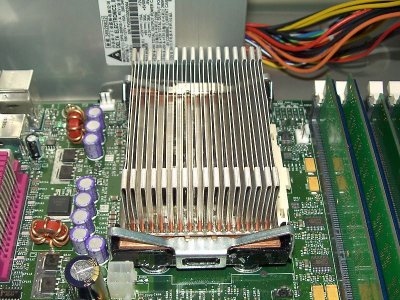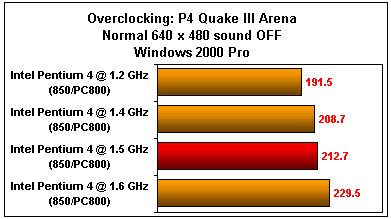De officiële release van de Pentium 4 processor vandaag heeft voor een stortvloed aan reviews gezorgd. In deel 1 hebben we al een aantal van deze reviews opgesomd en hier in deel 2 komen er nog een aantal:
Planet Hardware geeft ons nog eens even een kort en krachtig overzicht van de features van de nieuwe Pentium 4 processor. De Pentium 4 neemt het in de standaard benchmarks op tegen de Pentium III, Thunderbird en Duron. Er werd hier helaas geen DDR geheugen gebruikt.
- Initially available in 1.4GHz and 1.5GHz versions
- Manufactured on a .18 micron process
- 217 mm^2 die-size (twice that of the P3
- 256kb L2 cache, 8kb L1 data cache, 12k µop execution cache
- Utilizes Intel's new NetBurst Architecture
- 20-stage hyperpipelined, superscaler, out of order design
- SSE2 extensions (over 144 new instructions added to SSE)
- 400MHz (effective) Front Side Bus (FSB)
- 3.2GB/s bandwidth provided by 400MHz FSB
- Double-Pumped ALU's (run at 2x core clock frequency)
[break]
Hot Hardware
Ook deze site kon het niet laten om de nieuwe 42 miljoen transistors tellende chip onder handen te nemen. Ze besteden niet zo veel aandacht aan de features van de chip, maar des te meer aan een enorm aantal benchmarks waaronder echte applicaties en spellen, maar ook syntetische benchmarks. Uiteraard zijn er ook de nodige foto's te bewonderen:[/break]By now, you may have noticed that there are a few more connectors on the motherboard than perhaps you are use to seeing. That is because the Intel D850GB Motherboard utilizes the new "ATX12V" specification to implement its power distribution. There are two more power connectors in addition to the standard ATX connector for the motherboard. The 12 Volt source connector has been added as well as something called the "Auxilary Power" connector. This last connector looks like one half of an AT power connector. Here is a mechanical drawing of the ATX12V connector specification.[break]
Sharky Extreme
Sharky houdt zijn reputatie hoog door 29 pagina's vol te schrijven over de Pentium 4, hij geeft veel uitgebreide uitleg over de features en nog meer benchmarks. Verder is er gekeken naar de overclockmogelijkheden van de Pentium 4. Op 1,8GHz wilde de processor niet draaien, hij resette zichzelf naar 1,6GHz, wat de hoogst haalbare waarde bleek te zijn. De 100MHz bleek echter genoeg voor een performance boost van bijna 17 FPS in Quake3: Arena. Dat is een goed teken, want we kunnen volgens de roadmaps over niet al te lange tijd 1,7GHz en 2,0GHz versies verwachten: [/break]Since the Pentium 4 is currently implemented in a single-processor architecture, we will withhold from dragging AMD's upcoming 760MP chipset into the fray. The 760 DDR chipset, on the other hand, is more than fair game here. While we have already seen that DDR memory paired with AMD's 200MHz EV6 bus does not deliver as much bandwidth as Intel's solution, the Athlon clocked 300MHz slower than the Pentium 4 is often able to match performance with the more expensive system. Undoubtedly AMD will run into the same architectural limitations that Intel did at some point in their .18-micron process, but as long as they follow the roadmap that they have made publicly available, the Athlon will remain highly competitive with the Pentium 4 in 2001.
[break]Voor diegenen onder ons die Duits spreken zijn er nog twee reviews te vinden:
TecChannel
Een aantal geheugenbenchmarks, SysMark, 3dMark en een aantal spellen. Niets nieuws onder de zon dus:
TB 1200 TB 1200 P3 1000 P3 1000 P4 1400 P4 1500 P4 1600 RAM PC133 PC2100 PC133 PC800 PC800 PC800 PC800 Move (MB/s) 231 291 199 186 737 741 738 Read (MB/s) 336 364 213 245 1175 1221 1283 Write (MB/s) 345 457 465 387 788 767 756 R/W (MB/s) 341 411 339 316 982 994 1020 ZDNet Duitsland
Hetzelfde verhaal, een beetje uitleg, een aantal spellen, WinStone en de conclusie dat de Pentium 4 nog veel te duur is:[/break]Eines ist allerdings auch klar: Intel wird mit aller Macht die Software-Optimierungen für den P4 nach vorne treiben. Damit ist es unter Umständen nicht mehr notwendig den P4 mit einer höheren Taktfrequenz als den Athlon zu versehen. So lange jedoch der P4 alleine auf der Rambus-Plattform verfügbar ist, wird er sich im Markt kaum durchsetzen. Schliesslich kostet allein ein P4-Mainboard mit 128 MByte Rambus schon so viel ein GHz-Athlon-Komplettsystem. Dazu kommen dann noch die Kosten für den Prozessor: Intel verlangt für den P4/1500 819 Dollar und für den P4/1400 644 Dollar.
Na al deze reviews is duidelijk geworden dat Intel's Pentium 4 een enorm complex, snel en stabiel platform inelkaar heeft geschroefd. Als eerste lid van de zevende generatie Intel processors is de Pentium 4 een platform met een enorm potentieel. Dat moest ook haast wel, want het Pentium 4 ontwerp zal ons hoogstwaarschijnlijk nog jaren lang achtervolgen. Helaas zijn er ook een aantal nadelen op dit moment, vooral de hoge prijzen maar ook het gebrek aan SSE2 optimized software zorgen ervoor dat de Pentium 4 niet zo aantrekkelijk is als hij had kunnen zijn. Over een paar maanden als de prijzen zakken en de kloksnelheid omhoog is gezet, waardoor hij een nog grotere voorsprong krijgt op zijn voorganger, zou de chip wel eens heel interessant kunnen worden ![]() .
.



